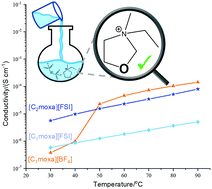Ionic liquids and plastic crystals utilising the oxazolidinium cation: the effect of ether functionality in the ring†
Abstract
The development of safer electrolytes is critical for the advancement of electrochemical energy storage applications. Ionic Liquids (ILs) and Organic Ionic Plastic Crystals (OIPCs) are attractive choices as electrolytes due to their high thermal stabilities and intrinsic ionic conductivities. However, fundamental understanding of the impact of cation and anion choice, to form ILs or OIPCs, is still lacking, particularly with regard to how this can affect the electrolyte properties. In this work, we explore the synthesis and characterisation of several oxazolidinium-based salts to understand the effect of the ether functional group in the cation ring. Specifically, we investigate the 3,3-dimethyloxazolidinium ([C1moxa]+) cation, paired with dicyanamide ([DCA]−), bis(fluorosulfonyl)imide ([FSI]−), bis(trifluoromethanesulfonyl)imide ([TFSI]−), tetrafluoroborate ([BF4]−) and hexafluorophosphate ([PF6]−) anions. In addition to investigating the influence of the anion, the effect of changing the cation side chain is examined with 3-ethyl-3-methyloxazolidinium bis(fluorosulfonyl)imide ([C2moxa][FSI]). Studies of thermal behaviour revealed that these oxazolidinium-based salts can be highly disordered and exhibit wide phase I temperature ranges. The transport properties of the salts were determined by examining the ionic conductivity, ion dynamics using solid-state Nuclear Magnetic Resonance (NMR) analysis, and the free volume through Positron Annihilation Spectroscopy (PALS). It was found that oxazolidinium-based salts exhibit faster ion transport than the equivalent pyrrolidinium-based salts, which is consistent with the larger free volume. Hence, oxazolidinium-based salts demonstrate scope as promising electrolytes for battery applications due to their high ionic conductivity and good thermal and electrochemical stability.



 Please wait while we load your content...
Please wait while we load your content...